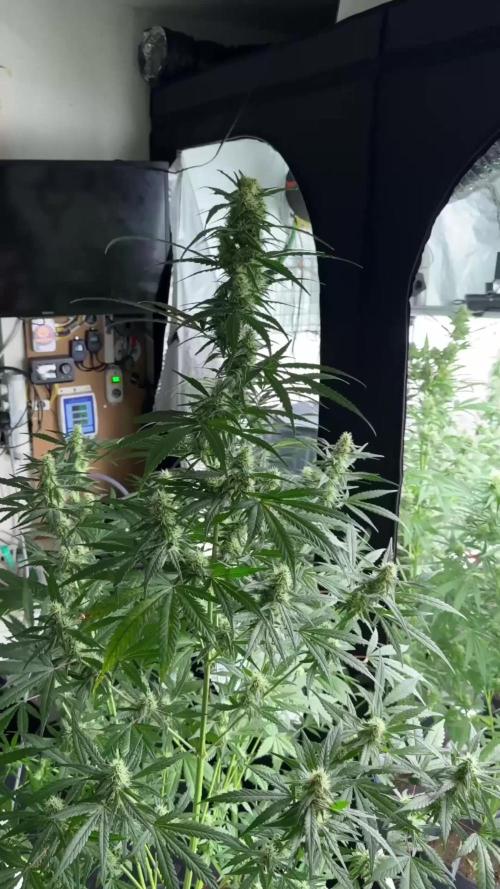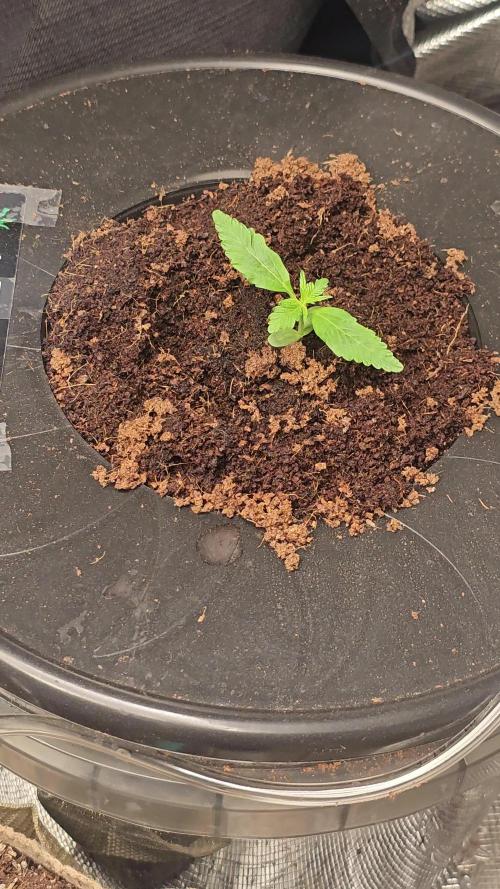The Grow Awards 2026 🏆 



























Likes
Comments
Share


@BiofuelEmpire
Follow
Getting close a little mire swelling to do chopped the snow ryder about another week till she dry already been five days smells so delicious like mango n citrus
Likes
295
Share


@Ju_Bps
Follow
Hello growmies 👩🌾👨🌾🌲🌲,
👋 This one is also still happy and like the food,
I don't really know how big they are with all the leaves, will be the surprise on the harvest, buts I see them bump, and got more frosty each days 😋😋😋❄️
💪keep removing some leaves 🍃
💧 Give water each 2/3 day
1.5 l Water + Roots + Zym + Bloom + Green Sensation (1 + 1 + 5 + 1 ml/l)
1.5 l Water + Roots + Zym + Bloom + Green Sensation + Sugar Royal (1 + 1 + 5 + 1 + 1 ml/l)
1.5 l Water + Roots + Zym + Bloom + Green Sensation (1 + 1 + 5 + 1 + 1ml/l)
PH @6
💡Mars Hydro - FC 3000
50% 48 cm.
Mars Hydro Fan kit
Setting 6, don't need more for the moment, no smeel out of the tent.
Have a good week and see you next week 👋
Thanks community for follow, likes, comments, always a pleasure 👩🌾👨🌾❤️🌲
Mars Hydro - Smart FC3000 300W Samsung LM301B LED Grow Light💡💡
https://www.mars-hydro.com/fc-3000-samsung-lm301b-led-grow-light
Mars Hydro - 6 Inch Inline Fan And Carbon Filter Combo With Thermostat Controller 💨💨
https://www.mars-hydro.com/6-inch-inline-duct-fan-and-carbon-filter-combo-with-thermostat-controller
Anesia Seeds - Deep Jealousy Auto🌲🌲
https://anesiaseeds.com/product/deep-jealousy-auto/
Likes
11
Share


@SeshHouseCannabis
Follow
This season is to compare between hydroponics and coco coir to see which is is better for each strain. The plant were doing real good, and heavy feeding will start soon. Thanks for following our diary👍🏻
Likes
18
Share


@MadeInGermany
Follow
Hey everyone 😃.
This week she has done great 👍.
It was done again on all the drifted topping and sprayed one last time with neem oil so that the last trips are finally gone 😁.
We haven't had any pests for so many years and all of a sudden we have such little shit parts 😅.
This week it was poured twice with 1.2 l of water.
GHSC enhancer was added during a pouring (1 g per l)
The tent was cleaned every day this week and the plants were checked for health.
The humidifier is filled once a day.
Next week I will decide how I will continue the training because I have space again in the flower tent 😀.
Until then, I wish you and your families a good start into the new year 2021 🙏🏻.
Stay healthy and let it grow 🍀
You can buy this Strain at :
https://sweetseeds.es/de/red-mandarine-f1-fast-version/
Type:
Red Mandarine F1 Fast Version
☝️🏼
Genetics:
Red Poison Auto®️ (SWS39)
X
Tangie (California Orange x Hybrid Skunk)
👍
Vega lamp:
2 x Todogrow Led
Quantum Board 100 W
💡
Bloom Lamp :
2 x Todogrow Led
Cxb 3590 COB 3500 K 205W
💡💡☝️🏼
Soil :
Canna Coco Professional +
☝️🏼
Fertilizer:
Green House Powder Feeding
☝️🏼🌱
Water:
Osmosis water mixed with normal water (24 hours stale that the chlorine evaporates) to 0.2 EC. Add Cal / Mag to 0.4 Ec Ph with Organic Ph - to 5.5 - 5.8 .
Likes
12
Share


@prebiancagrower
Follow
Hi guys.
Lovely strain as well, the smell and the bud colours are amazing!
Thanks RQS!!!
Likes
16
Share


@eldruida_lamota
Follow
Vamos cómo van estos clones de Haribo y Le xupet Negre, no veas qué vigorosos y cómo están ensanchando parecen lechugas.
Nudos bastante cortos y buen tallo, enraizaron muy bien y con el trasplante agradecieron y libertad radicular.
Me faltan algunas cosillas por comprar pero ya terminaré de montar todo esta semana e igual dejo algún vídeo en el futuro de la sala de verduras.
El único defecto que podría poner hasta ahora de las condiciones podría ser la temperatura que no termina de bajar, tengo maximas de 27 y eso no lo tengo que permitir.
7/8 podas aplicadas entre apicales y FIM, sólo hubo una que todavía no toque.
Pocos cambios en la alimentación, subí un poco el Grow de Advanced y ya.
Hasta aquí es todo esta semana , buenos humos 💨💨💨
Likes
42
Share


@Xi_Ve
Follow
This week was a lot going on!
The girls started to flower... The ones in the pouches stayed small because I think they didn't get enough water.
I'm gonna take care of that from now on, so there is still hope they grow more in the next 2 weeks. Stopped with B52 at the beginning of the week.
Just did LST and Leaf-Tucking dail. They are responding well to training but the temperatures are getting colder so I'm gonna have to find a way to keep them above 20C during the 4 hours lights-off time.
Maybe i also find something to get them off the ground. Light is at approx. 80cm, 240W since the beginning of the week. Gonna lower it when they grow some more leaves. Saving the 300W for flowering.
Also, I misted once with Cal-Mag this week, just to help the grow.
That's pretty much it for this week, I hope they grow more because there is plenty of space in the tent.
Thank you for checking out my diary for this week, there are a lot of images and also one video so if you have time check them out and feel free to ask any question/give me a suggestion since this is my 2nd grow, the first one wasn't that much successful.
Peace out
Likes
5
Share


@Misterindoor
Follow
Esta semana pasa a floracion y continua la estimulacion con delta 9 y mañana cambia el fotoperiodo a 12 /12
Likes
8
Share


@Slobasian
Follow
Have about 10 flavors still trying to decide on what exactly I’m doing I chopped them in half, I’m excited to see these flowers from the outdoor grow I have
Likes
16
Share


@DogDoctorOfficial
Follow
🌸 BlueBerry – Week 5 Flower Report
Grower’s Journal | Zamnesia BlueBerry
⸻
🌱 The Girls in Full Bloom
Both BlueBerry #1 and #2 are absolutely stunning this week:
• Size: Towering beauties, full presence in the room.
• Bud Formation: Large, well-stacked flowers building from bottom to top, showing the real effect of the ICL 300 inner canopy lights.
• Pheno Difference:
• Pheno #1 is forming a dominant central cola, reaching tall and thick — a real spear.
• Pheno #2 is slightly more balanced across branches, but still bulking fast.
• Hairs (Pistils): Beautiful white pistils everywhere — vibrant, strong, and reaching out like nature’s way of saying, “I’m ready to bloom.”
This early hair explosion is a promise of dense, resinous flowers soon to come.
⸻
💡 ICL 300 – Fruits of the Light
The inner canopy lights are proving their worth:
• Buds aren’t just forming at the top, but all the way down the structure.
• No wasted shadow zones, no underdeveloped sites.
• It feels like the plant is blooming in 360°, thanks to the way the ICL spreads light deep into the canopy.
The difference between a regular top light and this combination is day and night, and now it’s visible in every flower forming.
⸻
Nutrition Update – Bringing Back All-In-One Liquid
This week we reintroduced the Aptus All-In-One Liquid into the feeding mix. Why?
• To give the plants a broad-spectrum nutritional push right at mid-flower.
• Ensures no deficiency or slowdown during this critical bud development stage.
• Works hand in hand with Top Booster and CalMag to support cell expansion and flower density.
At this stage, the girls are hungry and hard at work, so it’s the right time to fuel them properly.
⸻
🔄 Quick Recap of the Journey So Far
• Cannakan germination → soil prep with Aptus amendments → steady veg → training + defoliation → flower induction.
• Week 4 brought early frost and strong stacking.
• Week 5 now brings real bulk, pistil fireworks, and inner canopy buds rising.
This has been a textbook BlueBerry journey so far — stable, strong, beautiful.
⸻
🔮 What to Expect Next (Week 6 and Beyond)
• More Bud Bulk: Flowers will gain weight and density quickly from here.
• Pistil Transition: Some of those white hairs will start to orange and curl as new sets keep pushing.
• Trichome Explosion: Frost will build across leaves and flowers, giving that snowy BlueBerry look.
• Terpenes Rising: Expect the first real waves of that nostalgic, sweet-fruity BlueBerry scent.
What not to expect: major height gain. The stretch is over, from here, all energy goes into flower expansion and resin production.
⸻
💬 Final Thoughts
Week 5 is the moment where the BlueBerry girls are no longer just “plants” — they are flowering powerhouses. Frost, pistils, bulk, and balance.
With the ICL 300 feeding the canopy from the inside and the All-In-One Liquid giving them the push they need, these ladies are on track to become legends in their own right.
BlueBerry #1’s towering cola and BlueBerry #2’s even structure are both testaments to genetic quality and environmental harmony.
It’s a pleasure to watch them evolve — and even more to share their journey 🌸✨.
📲 Don’t forget to Subscribe and follow me on Instagram and YouTube @DogDoctorOfficial for exclusive content, real-time updates, and behind-the-scenes magic. We’ve got so much more coming, including transplanting and all the amazing techniques that go along with it. You won’t want to miss it.
• GrowDiaries Journal: https://growdiaries.com/grower/dogdoctorofficial
• Instagram: https://www.instagram.com/dogdoctorofficial/ • YouTube: https://www.youtube.com/@dogdoctorofficial
⸻
Explore the Gear that Powers My Grow
If you’re curious about the tech I’m using, check out these links:
• Genetics, gear, nutrients, and more – Zamnesia: https://www.zamnesia.com/
• Environmental control & automation – TrolMaster: https://www.trolmaster.eu/
• Advanced LED lighting – Future of Grow: https://www.futureofgrow.com/
• Root and growth nutrition – Aptus Holland: https://aptus-holland.com/
• Nutrient systems & boosters – Plagron: https://plagron.com/en/
• Soil & substrate excellence – PRO-MIX BX: https://www.pthorticulture.com/en-us/products/pro-mix-bx-mycorrhizae
• Curing and storage – Grove Bags: https://grovebags.com/
⸻
We’ve got much more coming as we move through the grow cycles. Trust me, you won’t want to miss the next steps, let’s push the boundaries of indoor horticulture together!
As always, this is shared for educational purposes, aiming to spread understanding and appreciation for this plant. Let’s celebrate it responsibly and continue to learn and grow together.
With true love comes happiness. Always believe in yourself, and always do things expecting nothing and with an open heart. Be a giver, and the universe will give back in ways you could never imagine.
💚 Growers love to all 💚
Likes
14
Share


@GodZilla_Owner
Follow
Week 10 Update – Full Throttle with Advanced Nutrients 🌱
I’m now feeding 100% of the Advanced Nutrients schedule with all components. I noticed a slight calcium deficiency in the AN plants, so I’ve increased the base nutrients from 75% to 100%. Advanced Nutrients CalMag Xtra remains at 1ml/L, and it has been reliable throughout the grow with 0 EC osmosis water.
BioBizz#1 – BT42
The trichome ripeness is mixed—there are both amber and clear trichomes, so it’s not quite consistent yet. CalMag issues show up occasionally, but nothing that’s throwing me off balance—she’s doing fine! 🤞
AN#4 – BT42
She’s asking for a bit more calcium here and there but continues to dominate BioBizz#1 in terms of development.
EC: 2.5
pH: 6.4
Drain: pH 6.1 (EC not measurable due to organic soil).
AN#3 – BT38
This plant is visually about 2 weeks behind the others. The space between her and the lamp is down to 1-2cm—a disaster, but there’s nothing I can do at this point. PPFD is off the charts (1200), but she’s handling it and developing beautiful buds. Big respect to this strain—the stretch was no joke!
Humidity is well under control at
Likes
9
Share


@Staffedition
Follow
Привет друзья.
Наше знакомства продолжается с новым сортом автоцветущих растений от Smail_Seeds сорт ORIGINAL AUTO CHEMZKITTLEZ F1 reg.
Сегодня растению 66 дней.
Растение очень хорошо развивается, ни каких сбоев в генетике не наблюдается.
Шишки наливаются очень хорошо😀
Так же стрессую, что бы получить пыльцу.
Скоро будут феминизированные растения.
Сорт выводим сами.
Смотри мой профиль, у нас всегда есть что то интересное.
Не забудь поставить лайк❤️, если понравилась как прошла неделя
И читайте наш TELEGRAM: https://t.me/smail_seeds
#Smail_Seeds 😀
Likes
17
Share


@Sergio_721
Follow
So far it seems to be fine even if the high humidity worries me even if the temperatures are still high then they have stopped growing and will finally focus on the flowers and slowly we recover these small deficiencies
Processing
Likes
22
Share


@B4niTa
Follow
Week5 flowering stage begins
Day32 girls are bigger everyday, they start giving a nice aroma, at next week im must starting taking out girls for making photos :D





























